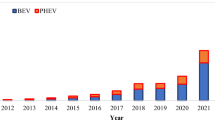Abstract
This study reports the results of a comparison made using life cycle assessment (LCA) analysis of the environmental impact of nine different sandwich material models (SMs). The objective is to reveal whether the candidate materials considered for a railway passenger vehicle (conventional or high-speed train) are green/environmentally friendly or not. For this aim, life cycle approach enables to take into account the light weighting gain without disregarding the environmental impact of manufacturing process. These SMs are designed as combinations of existing traditional and candidate materials, such as steel, aluminium, carbon/glass fibre–reinforced plastics (CFRP/GFRP), aluminium honeycomb, and polymer foam core. The environmental performance of these nine different models has been calculated via the LCA analysis with CML-IA v.3.0 impact assessment methodology in a SimaPro 8.5.0. The system boundaries in the LCA analysis include “cradle to grave” process of sandwich composite materials in the railway passenger vehicle. The functional unit was selected as “one product of SM” for each configuration; besides, this panel has a lifetime span of 25 years at 400,000 vehicle-km per year in the vehicle operation. The results show that the use-phase, which dominates the environmental impact of the SMs of the railway passenger vehicle car body, is itself largely affected by electricity generation. In particular, the mass reduction in the models also achieved a reduction in environmental impact over its lifetime, mainly owing to decreased energy consumption. Another important finding regarding the manufacture of certain models (such as CFRP and GFRP) for lightweight design, is that assessment, based solely on mass reduction, may not always have better environmental performance or be reliable due to the manufacturing impact.






Similar content being viewed by others
References
Bachmann J, Hidalgo C, Bricout S (2017) Environmental analysis of innovative sustainable composites with potential use in aviation sector—a life cycle assessment review. Sci China Technol Sci 60:1301–1317. https://doi.org/10.1007/s11431-016-9094-y
Cuartero J, Miravete A, Sanz R (2011) Design and calculation of a railway car composite roof under concrete cube crash. Int J Crashworthiness 16:41–47. https://doi.org/10.1080/13588265.2010.501163
Cunliffe AM, Jones N, Williams PT (2003) Recycling of fibre-reinforced polymeric waste by pyrolysis: thermo-gravimetric and bench-scale investigations. J Anal Appl Pyrolysis 70:315–338. https://doi.org/10.1016/S0165-2370(02)00161-4
Das S (2011) Life cycle assessment of carbon fiber-reinforced polymer composites. Int J Life Cycle Assess 16:268–282. https://doi.org/10.1007/s11367-011-0264-z
Del Pero F, Delogu M, Pierini M, Bonaffini D (2015) Life cycle assessment of a heavy metro train. J Clean Prod 87:787–799. https://doi.org/10.1016/j.jclepro.2014.09.023
Delogu M, Del Pero F, Berzi L et al (2017) End-of-life in the railway sector: analysis of recyclability and recoverability for different vehicle case studies. Waste Manag 60:439–450. https://doi.org/10.1016/j.wasman.2016.09.034
Ecoinvent (2010) Ecoinvent database v 2.2. Swiss Centre for Life Cycle Inventories, Dübendorf
Egede P (2017) Environmental assessment of lightweight electric vehicles. In: Sustainable production, life cycle engineering and management. Springer, pp. 9–40
European Commision (2018) EU energy in figures. Luxembourg
Font R, Fullana A, Caballero JA, Candela J, Garcia A (2001) Pyrolysis study of polyurethane. J Anal Appl Pyrolysis 58–59:63–77. https://doi.org/10.1016/S0165-2370(00)00138-8
Groen EA, Heijungs R, Bokkers E A M, de Boer I (2014) Sensitivity analysis in life cycle assessment. Proc 9th Int Conf LCA Food San Fr USA 8–10 Oct 2014 482–488. https://doi.org/10.1111/j.1939-1676.2008.0227.x
Günkaya Z, Özdemir A, Özkan A, Banar M (2016) Environmental performance of electricity generation based on resources: a life cycle assessment case study in Turkey. Sustain 8:1–14. https://doi.org/10.3390/su8111097
Herrmann C, Dewulf W, Hauschild M, Kaluza A, Kara S, Skerlos S (2018) Life cycle engineering of lightweight structures. CIRP Ann 67:651–672. https://doi.org/10.1016/j.cirp.2018.05.008
Hudson CW, Carruthers JJ, Robinson AM (2010) Multiple objective optimisation of composite sandwich structures for rail vehicle floor panels. Compos Struct 92:2077–2082. https://doi.org/10.1016/j.compstruct.2009.10.018
Ingarao G, Deng Y, Marino R, di Lorenzo R, Lo Franco A (2016) Energy and CO2 life cycle inventory issues for aluminum based components: the case study of a high speed train window panel. J Clean Prod 126:493–503. https://doi.org/10.1016/j.jclepro.2016.03.070
ISO (2019) ISO 21106:2019 Railway applications—recyclability and recoverability calculation method for rolling stock
Kaewunruen S, Rungskunroch P, Jennings DV (2019) A through-life evaluation of end-of-life rolling stocks considering asset recycling, energy recovering, and financial benefit. J Clean Prod 212:1008–1024. https://doi.org/10.1016/j.jclepro.2018.11.271
Khalil YF (2017) Eco-efficient lightweight carbon-fiber reinforced polymer for environmentally greener commercial aviation industry. Sustain Prod Consum 12:16–26. https://doi.org/10.1016/j.spc.2017.05.004
Kim JS, Lee SJ, Shin KB (2007) Manufacturing and structural safety evaluation of a composite train car body. Compos Struct 78:468–476. https://doi.org/10.1016/j.compstruct.2005.11.006
La Rosa AD, Banatao DR, Pastine SJ et al (2016) Recycling treatment of carbon fibre/epoxy composites: materials recovery and characterization and environmental impacts through life cycle assessment. Compos Part B Eng 104:17–25. https://doi.org/10.1016/j.compositesb.2016.08.015
Lee CK, Kim YK, Pruitichaiwiboon P, Kim JS, Lee KM, Ju CS (2010) Assessing environmentally friendly recycling methods for composite bodies of railway rolling stock using life-cycle analysis. Transp Res Part D Transp Environ 15:197–203. https://doi.org/10.1016/j.trd.2010.02.001
Lee CK, Lee JY, Kim J (2020) Recyclability and recoverability of rolling stock with recycling efficiency factors. Resour Conserv Recycl 155:104620. https://doi.org/10.1016/j.resconrec.2019.104620
Luz SM, Caldeira-Pires A, Ferrão PMC (2010) Environmental benefits of substituting talc by sugarcane bagasse fibers as reinforcement in polypropylene composites: Ecodesign and LCA as strategy for automotive components. Resour Conserv Recycl 54:1135–1144. https://doi.org/10.1016/j.resconrec.2010.03.009
Mayyas AT, Qattawi A, Mayyas AR, Omar MA (2012) Life cycle assessment-based selection for a sustainable lightweight body-in-white design. Energy 39:412–425. https://doi.org/10.1016/j.energy.2011.12.033
Naqvi SR, Prabhakara HM, Bramer EA, Dierkes W, Akkerman R, Brem G (2018) A critical review on recycling of end-of-life carbon fibre/glass fibre reinforced composites waste using pyrolysis towards a circular economy. Resour Conserv Recycl 136:118–129. https://doi.org/10.1016/j.resconrec.2018.04.013
Önder A (2017) Harmonised method to validate the impact resistance performance of composite passenger railway car bodies
REFRESCO Project (2013) REFRESCO project. http://www.refresco-project.eu/. Accessed 1 Jun 2016
Robinson M, Carruthers J, O’Neill C, Ingleton S, Grasso M (2012) Transport of DE-LIGHT: the design and prototyping of a lightweight crashworthy rail vehicle driver’s cab. Procedia Soc Behav Sci 48:672–681. https://doi.org/10.1016/j.sbspro.2012.06.1045
Schmidt JH, Watson J (2012) Eco Island Ferry-comparative LCA of island ferry with carbon fibre composite based and steel based structures 84. https://doi.org/10.1016/j.jnoncrysol.2012.12.045
Schwab Castella P, Blanc I, Gomez Ferrer M, Ecabert B, Wakeman M, Manson JA, Emery D, Han SH, Hong J, Jolliet O (2009) Integrating life cycle costs and environmental impacts of composite rail car-bodies for a Korean train. Int J Life Cycle Assess 14:429–442. https://doi.org/10.1007/s11367-009-0096-2
Segovia F, Blanchet P, Amor B, Barbuta C, Beauregard R (2019) Life cycle assessment contribution in the product development process: case study of wood aluminum-laminated panel. Sustain 11. https://doi.org/10.3390/su11082258
Shin KB, Hahn SH (2005) Evaluation of the structural integrity of hybrid railway carriage structures including the ageing effects of composite materials. Compos Struct 68:129–137. https://doi.org/10.1016/j.compstruct.2004.03.007
Song YS, Youn JR, Gutowski TG (2009) Life cycle energy analysis of fiber-reinforced composites. Compos Part A Appl Sci Manuf 40:1257–1265. https://doi.org/10.1016/j.compositesa.2009.05.020
Timmis AJ, Hodzic A, Koh L, Bonner M, Soutis C, Schäfer AW, Dray L (2015) Environmental impact assessment of aviation emission reduction through the implementation of composite materials. Int J Life Cycle Assess 20:233–243. https://doi.org/10.1007/s11367-014-0824-0
Torres A, De Marco I, Caballero BM et al (2009) Recycling of the solid residue obtained from the pyrolysis of fibre glass polyester sheet molding compound. Adv Polym Technol 26:141–149. https://doi.org/10.1002/adv
Ulianov C, Hyde P (2016) INNOWAG project, D1.1: benchmark and market drivers for an integrated intelligent and lightweight wagon solution
Ulianov C, Önder A, Peng Q (2018) Analysis and selection of materials for the design of lightweight railway vehicles. IOP Conf Ser Mater Sci Eng 292:012072. https://doi.org/10.1088/1757-899X/292/1/012072
UNIFE (2013) Recyclability and recoverability calculation method railway rolling stock
Watson N (2011) The Shinkansen-Japanese High Speed Railway Network 35
Wennberg D (2009) A light weight car body for high-speed trains 51
Wennberg D (2013) Multi-functional composite design concepts for rail vehicle car bodies. KTH Royal Institute of Technology
Witik RA, Payet J, Michaud V, Ludwig C, Månson JAE (2011) Assessing the life cycle costs and environmental performance of lightweight materials in automobile applications. Compos Part A Appl Sci Manuf 42:1694–1709. https://doi.org/10.1016/j.compositesa.2011.07.024
Witik RA, Teuscher R, Michaud V, Ludwig C, Månson JAE (2013) Carbon fibre reinforced composite waste: an environmental assessment of recycling, energy recovery and landfilling. Compos Part A Appl Sci Manuf 49:89–99. https://doi.org/10.1016/j.compositesa.2013.02.009
Acknowledgements
The authors thank Prof. Dr. Müfide BANAR for infrastructure, academic advising, and supporting this research.
Author information
Authors and Affiliations
Corresponding author
Additional information
Responsible Editor: Philippe Loubet
Publisher’s note
Springer Nature remains neutral with regard to jurisdictional claims in published maps and institutional affiliations.
Electronic supplementary material
ESM 1
(DOCX 60.3 kb)
Rights and permissions
About this article
Cite this article
Özdemir, A., Önder, A. An environmental life cycle comparison of various sandwich composite panels for railway passenger vehicle applications. Environ Sci Pollut Res 27, 45076–45094 (2020). https://doi.org/10.1007/s11356-020-10352-8
Received:
Accepted:
Published:
Issue Date:
DOI: https://doi.org/10.1007/s11356-020-10352-8




